Hole 1 - 330/315yds - Par 4 - "Valley"This beautiful little opener gives the player an idea of what he will confront constantly during his round -- choices. Playing left to right, the choice of tee shot could be anything from a mid-iron to driver.

Overly timid or indifferent tee shots will catch this string of bunkers laid out short of the fairway. Note that the carry to the left is significantly farther than it appears from the tee.

While the aggressive line over these bunkers makes the green reachable for longer players, these bunkers will extract a severe price from an overly ambitious tee-shot hit by an overly confident player.

The green is elevated, obscuring parts of the putting surface and surrounding area from view on the approach. A severe false front will repel shots that come up short.

Balls missed left will find the bunkers in the foreground, while those right will encounter the series of random humps and mounds visible in the background.

The first green is rife with undulations and ridges, placing added importance on an accurate approach.

Missing left is no picnic . . .

. . . nor is missing right. This view from right-rear shows the large ridge bisecting the green. Being on the wrong side of this ridge is a recipe for a three-putt.

As seen from above: the bold internal contours of the first green at National.

Simply put, this is one of the best openers in golf.
 Hole 2 - 330/290yds - Par 4 - "Sahara"
Hole 2 - 330/290yds - Par 4 - "Sahara"Another gem of a short two-shot hole, the second again confronts the golfer with a decision from the tee -- be aggressive, hug the left side, carry the Sahara bunker and try to drive the green, or be safe, play out right and attempt what should be an easy par.

Though most of it is hidden from view from the tee, the Sahara bunker presents a formidable hazard.

An aggressive ball that carries the Sahara bunker is rewarded with a fairway that slopes directly into the putting surface.

While bailing out to the right to shorten the carry over the Sahara bunker might be considered the safe play, it is not entirely free of danger, as a ball too firmly struck on this line will carry down into a deep hollow, resulting in a difficult and blind approach.

The green is open across its full length, permitting balls to be run on to the surface, whether struck from the tee or the fairway. The Narrows, Redan and Alps are visible behind.

As this view back up the fairway shows, Macdonald provided an ample reward for players that successfully negotiated the risk of an ambitious line. Note that long is perhaps the worst miss of all, as the green drops immediately straight down some dozen feet, and can shed balls for some distance.

Sahara as seen from Alps -- note the fall off from the rear of the green and the deep hollow to the left of the frame. Along with the Alps, one of my favorite holes on the course, and as can also be said for the Alps, it will forever remain a mystery as to why such holes are no longer made.
 Hole 3 - 426/407yds - Par 4 - "Alps"
Hole 3 - 426/407yds - Par 4 - "Alps"One of my favorite holes in all of golf, Macdonald's rendition of the Alps is a magnificent and challenging two-shot hole. In opposition to the first two holes, which are shorter with fairways tending right to left, the Alps is a long, uphill hole with a fairway moving from left to right.

The first choice the player must make is to pick an appropriate line off the tee. The farther right the line, the longer the carry over the bunker, but the shorter and better the angle for the approach.

Once safely in the fairway, the player confronts another choice -- challenge the Alps hill and aim for the green (marked by a bell tower), or bail out up the right side and play for the green in three. Each route to the hole presents its own set of challenges. For what its worth, I agree with Ran Morrisett's assessment of the second shot as the finest blind shot in golf.

One of the primary difficulties of the second shot here is that, although Macdonald built the second green very large, he also ringed it with trouble, including the crossbunker fronting the green. A player can't "get away with one" on this hole -- it is a true test that must be met with a true golf shot.

Few thrills in golf can match hitting the third green at the National in two well-struck shots, and walking away with par or better here reminds the player of why he took up golf in the first place. Certainly, Alps is one of the finest par-4s in the world.
 Hole 4 - 195/181yds - Par 3 - "Redan"
Hole 4 - 195/181yds - Par 3 - "Redan"If the third hole at National is to be counted among the best two-shot holes in the game, certainly the fourth is among the best of the one-shot holes. The iconic American Redan, this hole is as beautiful as Redan's get, and plays as all Redan's should, which is to say, difficult.

The front right framing bunker is out of play for all but the most indifferent of shots, but the lefthand bunker presents a true hazard and makes direct approach to this green foolhardy.
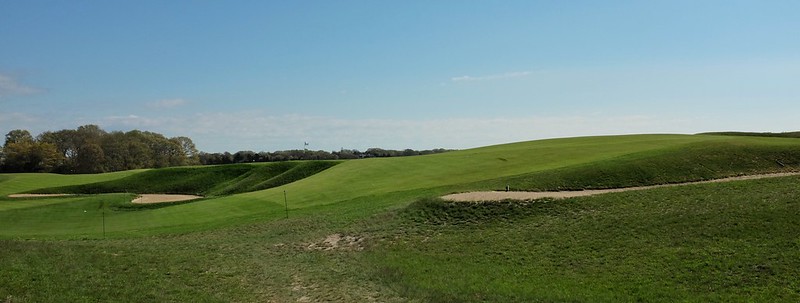
The severity of the slopes built into this Redan are unique among Macdonald's versions of this hole. Piping Rock's third, with its elevated green and deep front bunker, is likely the closest comparison.

The kickslope here is substantial enough to propel the ball to all potential hole locations on this large green, which, along with its right to left / front to back slope, contains its own set of undulations.

Shots missing long will find the back bunker, which is an extremely difficult recovery (as your author learned from experience).

Putting from above the hole is a supreme challenge.
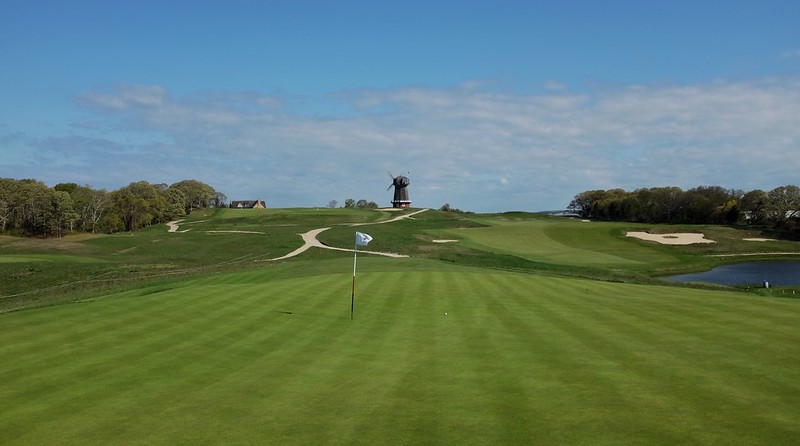
The finest Redan in American golf, and one of the best par-3 holes in the world.
 Hole 5 - 478/451yds - Par 4 - "Hog's Back"
Hole 5 - 478/451yds - Par 4 - "Hog's Back"The third of three difficult holes, the fifth at National asks for a tee shot over a formidable cross bunker cut into the hill to a fairway humped down its spine so as to shed balls to either side.

The fairway's natural ripples provide added visual and playing interest.

Longer drives will contend with this unique trench bunker that bisects the fairway. The green sits in the middle of this frame.

The wide, downsloping fairway leads straight into the green and will carry running approach shots a long way, allowing even shorter hitters to reach this long par-4 in two shots.

The approach at the fifth practically begs for a running shot.

These two bunkers left of the green strongly suggest that the player use the sloping right-to-left fairway to access the green.
 Hole 6 - 141/123yds - Par 3 - "Short"
Hole 6 - 141/123yds - Par 3 - "Short"A Macdonald original as fun as it is maddening, the sixth is the shortest hole at National and has one of the largest and wildest greens on the property. From the tee, the greens for Sebonack and Eden are visible to the right.
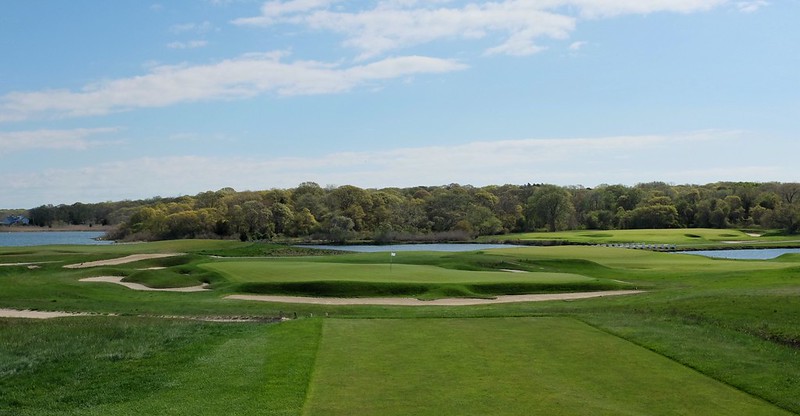
To say this green is heavily contoured is to understate the matter substantially. The large mound in the center of the green (on which today's pin sits) sheds balls in all directions, as does the larger green itself.
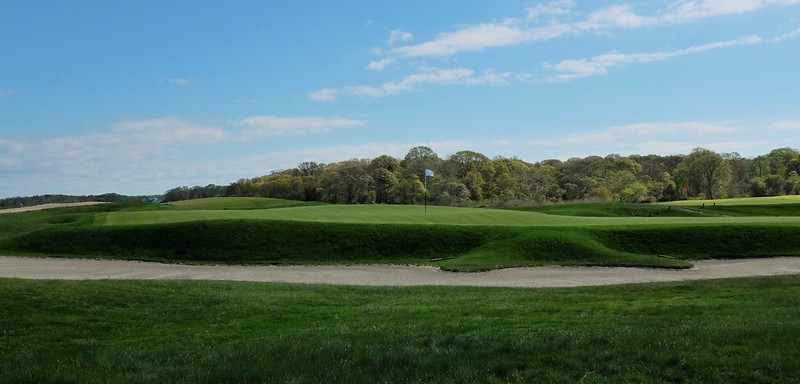
Any ball that fails to find (or hold) the putting surface is likely to end up in a bunker -- some more penal than others, like this little beauty here.
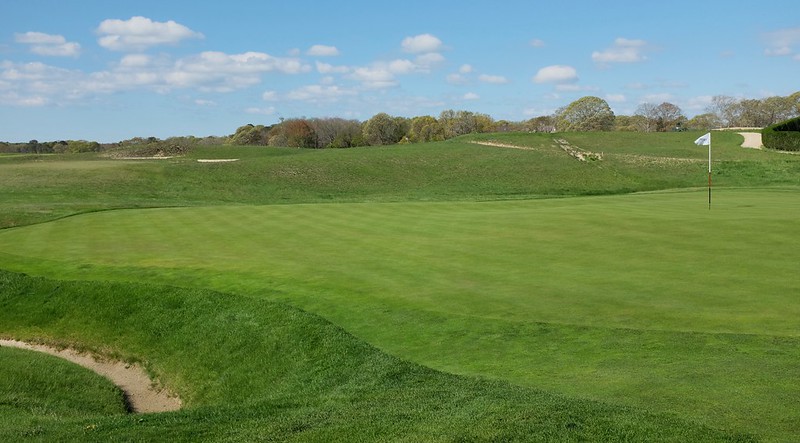
The degree of elevation change in this green, as seen from the right side, is quite striking and adds a wonderful element of challenge to an otherwise short hole.
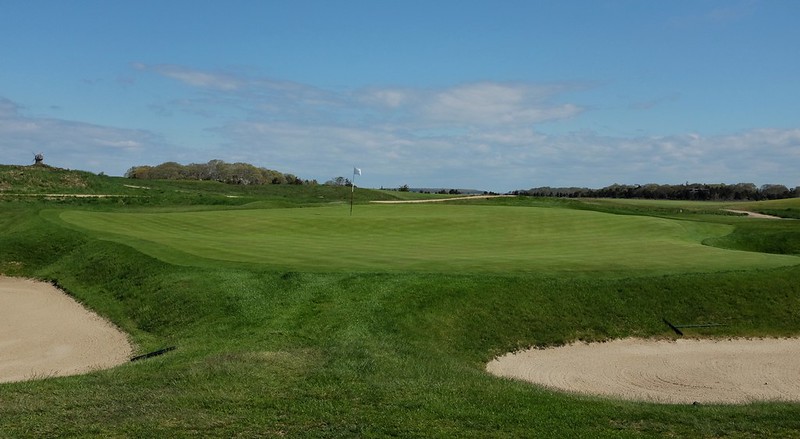 Hole 7 - 478/467yds - Par 5 - "St. Andrews"
Hole 7 - 478/467yds - Par 5 - "St. Andrews"The first three shot hole at National is Macdonald's tribute to the Road Hole at St. Andrews. A blind tee shot over a waste area is the first order of business.

The bunkering down the right must will catch any tee shots that stray that way. These bunkers are largely invisible from the tee.

The National is replete with interesting and unique terrain features, like this slash of a bunker and fronting mound.
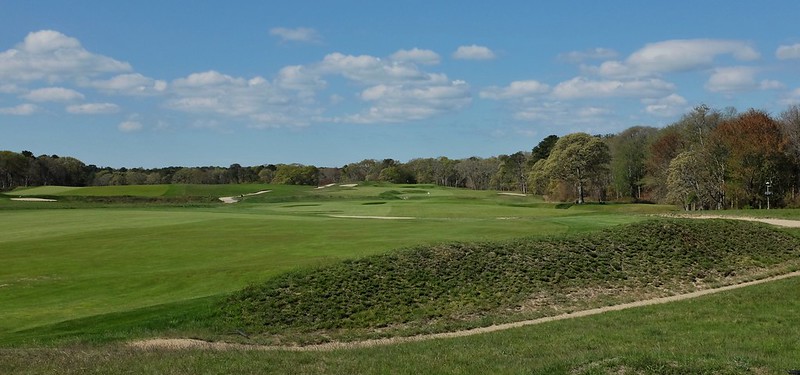
These two small bunkers in the area short of the green are so flat that they are invisible from a distance, adding to the uncertainty and challenge of the approach. The road bunker looms to the left of the elevated green.

The large green is elevated by a mere two feet or so, but this small feature adds exponentially to the difficulty of judging and hitting an approach shot. A brilliant feature.

The most formidable Road Hole bunker that Macdonald ever created, this monster has allegedly been softened over time.

Quite simply . . .

. . . avoid at all costs.

The green, while largely flat, slopes away on all sides and is harder to hold than it appears.

A large, deep bunker runs down the entire right side of the green, ready to catch those who decline to challenge the Road bunker.
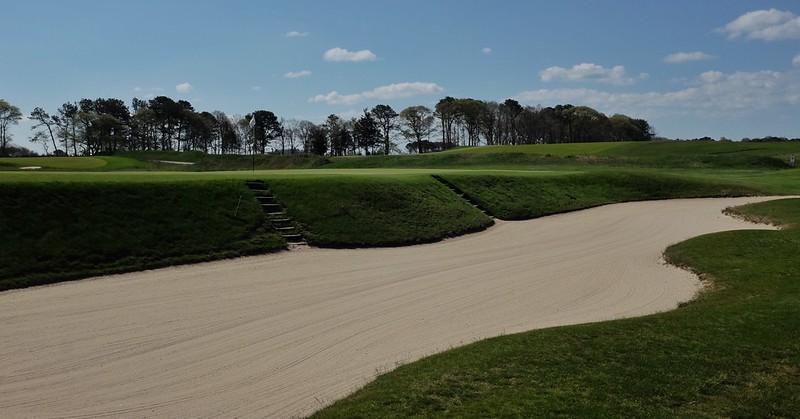
An exceptional three-shot hole in every respect.
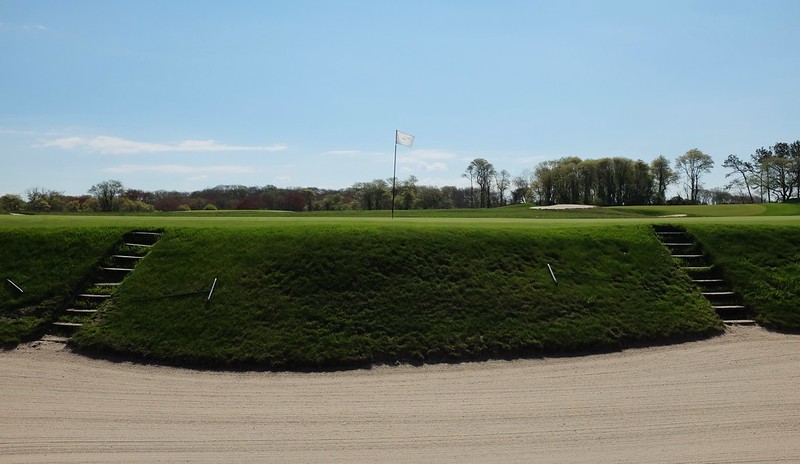 Hole 8 - 400/385yds - Par 4 - "Bottle"
Hole 8 - 400/385yds - Par 4 - "Bottle"Another template that has been largely lost with time, Macdonald's "Bottle" hole presents the option to take the straightforward tee shot down the right side, or attack the left side of the fairway and challenge the bunkers in return for a better view and angle into the green.

The tee shot on the eighth crosses Shrubland Road for the first time.

The Bottle bunkers that bisect the eighth hole are unique in design and formidable in their defense of the hole . . .
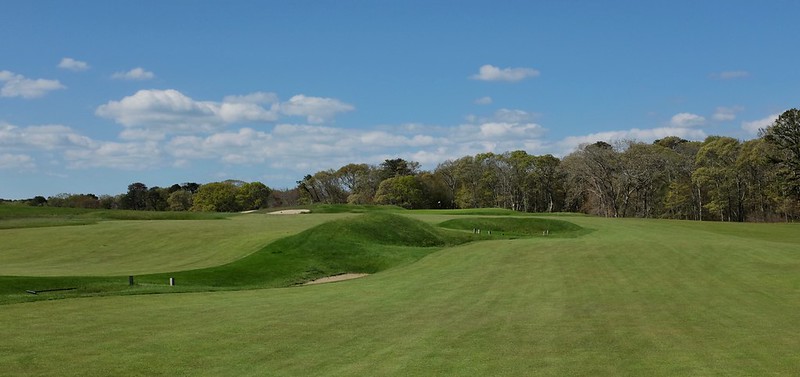
. . . and they play bigger than they look.

Between the Bottle bunkers and the green, Macdonald installed a Principal's Nose bunker complex.
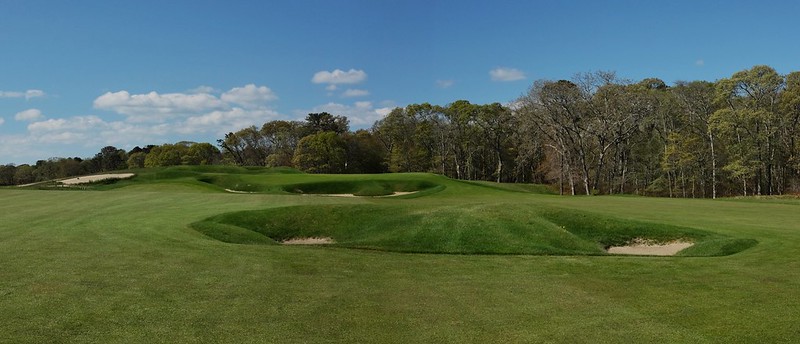
The green is substantially elevated with steep drops on three sides. Missing right is particularly penal.
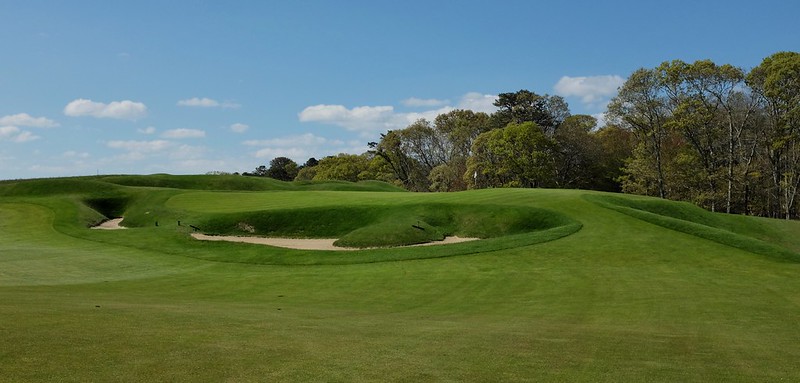
The view from behind the classic Bottle hole.
